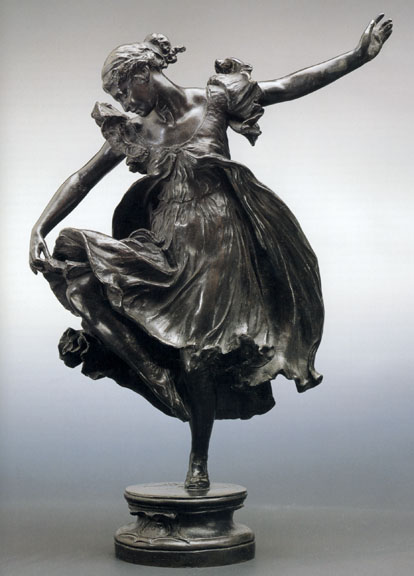
[Victorian Web Home —> Visual Arts —> Sculpture —> Sir W. Hamo Thornycroft —> Next]

Commentary by Peter Nahum and Sally Burgess
Sir William Hamo Thornycroft was the initiator of the "New Sculptors." He had visited Italy in 1871 and admired the work of Michelangelo, returning to react against the stiff formality of Neoclassicism and the sentimentality of the Romantic style. His life-size bronze, Teucer, of a naked archer (1881), changed the course of British sculpture. Joy, an aesthetic celebration of beauty, dance, music and life itself, echoes the flowing, sinuous qualities of Art Nouveau. ... In 1894 he started another figure in very vigorous action, a dancing girl which he described ... as his fin de sièle oeuvre. ... His dancing model proved very satisfactory, dancing to himfirst in the nude and then in a light frilly dress. He found it very firing work as did she, "working from moving drapery, but also eqjoyable.
The cast is a bronze statuette reduced from the plaster Joy of Life (whereabouts unknown) exhibited at the Royal Academy in 1895 (number 1701). The Art Journal wrote of the latter:
The Joy of Life, one hand uplifting her accordion plaited skirts — the folds of this are treated with a fragility one would not have believed possible in clay — and the other extended to maintain the graceful balance of her pirouette.
Thornycroft's finely cast and detailed statuettes were often exhibited at the Art Workers Guild exhibitions and, as Susan Beattie suggests in her essay, "The Cult of the Statuette" (61) Were integral in breaking the boundaries between the fine and applied art. Furthermore, Edmund Gosse, himself an admirer of Thornycroft, wrote an important article on "Sculpture in the House" in which he stated:
By far the most adequate way in which sculpture can be used in the house is by the introduction of statuettes. A great air of distinction and refinement is given to a room” by the presence of such figures.
Bibliography
Beattie, Susan. The New Sculpture. New Haven: Yale University Press, 1983.
Manning, Elfrida. Marble & Bronze The Art and Life of Hamo Thornycroft. Trefoil Books, London and New Jersey 1982. Pages 121-2, 204-5.
Nahum, Peter, and Sally Burgess. Pre-Raphaelite-Symbolist-Visionary. London: Peter Nahum at Leicester Galleries. Catalogue number 24.
Rosenblum, Robert, and Maryanne Stevens, Ann Dumas. 1900: Art at the Crossroads. Royal Academy of Arts, London, January-April 2000. Catalogue number 74.
Victorian
Web
Visual
Arts
Sculpture
W. Hamo
Thornycroft
Next
Last modified 17 July 2001